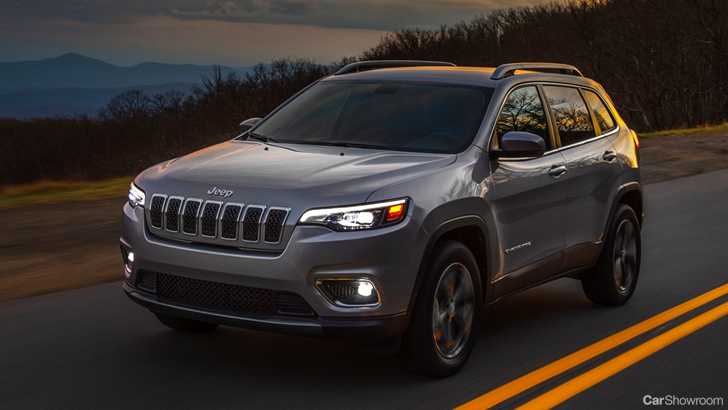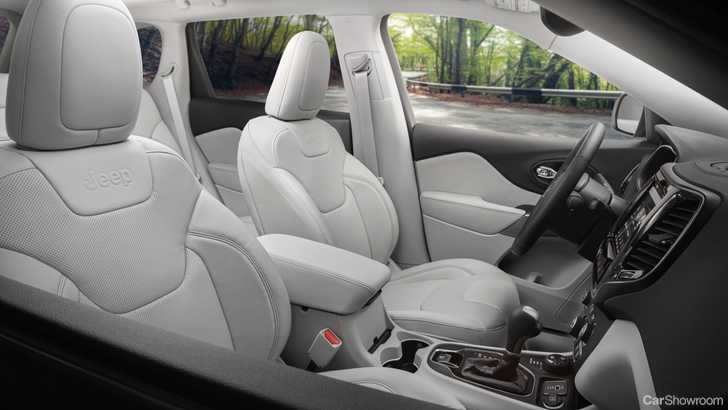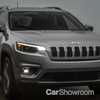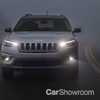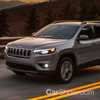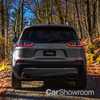New engines will match the new less-challenging face.
American SUV marque Jeep has, at long last, released details on its facelift Cherokee for the 2019 model year, shedding light on less-than-obvious but entirely-required changes for the mid-size model. While it’s been known publicly that the new Cherokee will carry revised looks and a mildly updated cabin (which you can read about here), what’s only just been clarified are changes under the skin, to the cabin, and to the kit list.
“A stunning, premium design and the addition of our new fuel-efficient 2.0-litre turbo engine make the new Jeep Cherokee even more desirable in the mid-size SUV segment. In addition, the Cherokee builds on its benchmark 4x4 capability and on-road dynamics with refinement and style, a host of new attributes, powertrains, and the latest technology that is perfectly situated for consumers worldwide.” — Mike Manley, Head of Jeep Brand, FCA Global
The 2019 Cherokee will be available in the US in Latitude, Latitude Plus, Limited, Overland, and Trailhawk, with the first batch of cars expected to arrive in showrooms in Q1 2018 (so why it’s being called a 2019 model, we’re not sure).
We’ll gloss over the big exterior revisions (which you can read about here), and narrow in on specific features. “Advanced LED lighting” is a major feature on the new Cherokee, with the front getting bi-LED projector headlamps, housed beneath “signature Cherokee DRLs,” with these being the most major contributors to the updated Cherokee’s look. There are dual LED fog-lamps available as well, flanking the radar-guided cruise control module down below. The red tow hooks of the Trailhawk model have been brought to Overland models too, though it ditches the red powder coat in favour of a chrome finish.
The rear lights are also of the LED variety, replete with a “Feature Light,” which non-Jeep marketing people would refer to as an LED light tube that frames the full internals of the taillight itself. As for the rear itself, the tailgate has been redesigned using lightweight composite material to make it lighter and easier to open and shut, while there is now a handsfree powered operation available as an option, triggered by a kicking motion behind the bumper.
The cabin has been “updated” to present itself in a “fresh and elegant” manner, while naturally retaining the practical requirements that are expected of a mid-size SUV. As such, there are things like a driver-oriented cockpit “loaded” with tech, as well as 8-airbags as standard, ensuring safety, security and convenience to all. There’s now high-gloss piano black and satin chrome trim dotted around the place, which Jeep says “add a delicate touch” around selected features. A repositioned USB port and power port are also noteworthy revisions.
The seats now receive revised finishings, with either “premium” fabric or Nappa leather available, with a ‘Hex’ graphic featuring on those premium cloth units. All Cherokees feature 60:40 split rear seats, which can also be slid back and forth to maximise legroom or cargo space. Lighter tones have been used on lower portions of the Cherokee’s cabin to aid a sense of airiness, while the optional full-length panoramic sunroof offers, to a degree, what Jeep says is the brand’s signature open-air experience.
Interestingly, Latitude and Latitude Plus models feature a unique Storm Blue cabin that was “inspired by Iceland with its dark volcanos, black ash, and blue skies.” As such, the the black seats are accented with Storm Blue stitching throughout.
In-cabin technology updates are headlined by UConnect upgrades, with the North American market offered with either 7.0-, 8.4-, and 8.4-NAV systems. Uprated processing power, refined features and functionality, and a faster boot-up time are among the highlights of the new UConnect systems, with features including things like Bluetooth, DAB digital radio, turn-by-turn navigation, and a customisable menu bar below. Further, connected services are now offered on the Cherokee, allowing a smartphone app to lock, unlock, and even start their vehicles remotely. These connected features also allow the Cherokee to alert the authorities automatically in the event of a minor collision, medical emergency, or anything else for that matter, by simply hitting the SOS button on the rear-view mirror.
All cars now feature Apple CarPlay and Android Auto as standard. A 7-inch fully-customisable instrument cluster sits ahead of the driver on higher end models, while lower-grades make do with a “world class TFT LED display” measuring a paltry 3.5-inches.
The engines are perhaps the biggest update for the new model year, and definitely what people want to know most about. For starters, the 2.0-litre turbocharged motor from the new Wrangler has been brought to the Cherokee lineup. The inline-four motor features a twin-scroll turbocharger mounted directly to the cylinder head in a bid to reduce emissions and improve durability. 201kW and 400Nm is available to the driver, paired with a 9-speed automatic gearbox, which will aid motorway economy. But urban economy has been improved too, thanks to an engine stop-start system that is said to improve fuel economy by up to 10%.
Should you prefer your engines naturally-aspirated, there’s still a 2.4-litre Tigershark inline-4 petrol mill available, with some 134kW and 230Nm on tap, though it’s been refined over the outgoing car to improve fuel consumption by up to 7.5%. The 3.2-litre Pentastar V6 is also available, standard on the Trailhawk, which produces 202kW and 324Nm (just 1kW less than the turbo-4, but down on torque by a considerable 76Nm).
The new Cherokee touts “superior on-road performance,” thanks to a heavily revised suspension setup, as well as a new electric power steering system. The latter system promises to offer effortless low-speed manoeuvrability and more direct high-speed agility, while also enabling the addition of a whole host of new safety features. Lane departure warning and lane keep assist get tacked on, for example, as have semi-autonomous parking capabilities.
Jeep Active Drive I and Active Drive II are available (for Cherokees without active suspension and with it, respectively), with both systems allowing for greater off-road ability with little to no compromise. A crawl ratio is also available for Active Drive II equipped vehicles, allowing the car to make best use of the torque available for slow-speed, highly-coordinated manoeuvres.
Safety is well catered for with the new Cherokee too, as befitting a family SUV. IN addition to the eight airbags we mentioned earlier, Jeep says the new Cherokee has as many as 80 available safety & security features. To name a few, there’s the semi-autonomous parking capability we talked about earlier, as well as intelligent cruise control and autonomous emergency braking, collision warning, lane departure warning, electronic stability control, roll mitigation, blind-spot monitoring, rear cross-traffic alert, and ParkView (which is a reversing camera, not a condo).
Overall, you could say that Jeep’s put in a lot of effort to right a lot of the issues we used to have with the Jeep Cherokee, with the new face perhaps being the most minor change of them all. While we remain skeptical of the “premium” quality of the cabin (for obvious reasons), if priced competitively enough, the new Cherokee might prove a pretty considerable contender against segment dominators like the BMW X3, Audi Q5, and Land Rover Discovery Sport.
